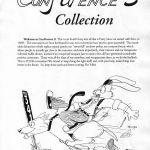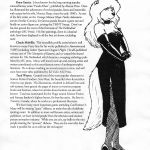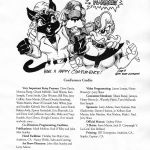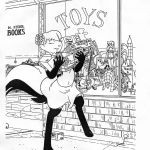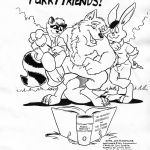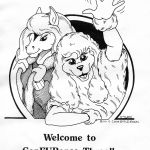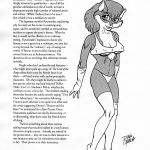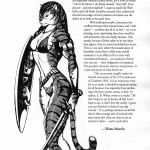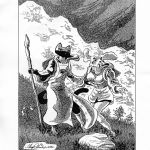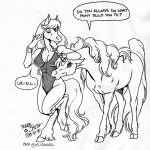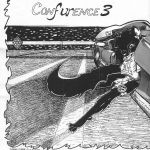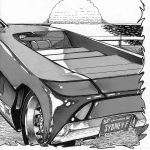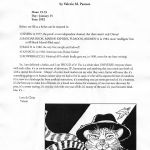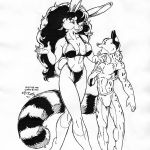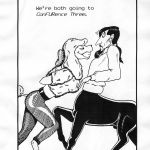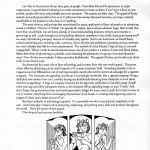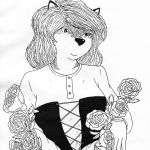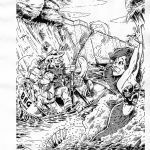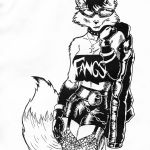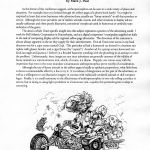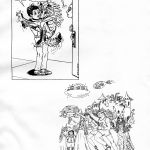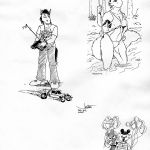Welcome to ConFurence 3! This is our fourth foray into all that is Furry (since we started with Zero, in 1989). The innovations we have developed for our own convention have proven quite successful! The round¬ table discussions which replace typical panels; our “never full” art show policy; our costume forum, which allows people to actually get close to the costumes, and more importandy, their creators; and our inexpensive informal buffet dinner, instead of an overpriced banquet; just to name a few, all have generated considerable positive comments. These were all the ideas of our members, and we appreciate them, as we do the feedback. This is YOUR convention! We intend to keep doing the right stuff, and, with your help, make things even better in the future. So, keep those cards and letters coming, Fur Folks!
Our Guests of Honor:
Dave Garda: Is best known for the long running popular science/fantasy series “Panda Khan”, published by Abacus Press. Dave has illustrated the adventures of evolved pandas, bears and insectoids; with scripts by his wife, Monica Sharp, since the early 1980’s. As one of the first artists on the Teenage Mutant Ninja Turtles Adventures comics (Archie Comics), his famous panda became a guest star and finally an action figure toy, joining the TMNT lineup. Dave’s art ) has also graced the cover of the first issue of The Furkindred u anthology (MU Press). His fine paintings, done in a classical style, have been displayed in all the best art shows, including ours!
Chuck Melville: This incredibly prolific artist/writer is well known to many Furiy fans for his works published in Furversion and YARF!, including Seekers Quest and Dragon’s Plight. He self-published volume one of The Champion of Katana, and co-created the shared universe for The Furkindred, which became a sweeping anthology pub¬ lished by MU press. Many well known and up-and-coming artists and writers contributed to this most famous tome of anthropomorphic literature. He is always working on several projects at once, and will soon have more tides published by Ed Vick’s MU Press.
Taral Wayne: Created one of the most popular characters in Science Fiction Fandom, Sara Maar, the beautiful silver-furred alien visitor to our planet. His illustrations, rendered in delicate lines and soft textures, have graced the pages of many convention program books and fanzines, where his articles about fandom are also well known. Taral was nominated for the Hugo award, Science Fiction and Fantasy fandom’s highest honor, for best fan artist. He lives in Toronto, Canada, where he works as a professional illustrator.
We have many more important guests attending ConFurence 3. Many will be wearing “guest” ribbons, to make the task of celebrity spotting easier. In addition to more well known artists, writers and publishers, we have invited people from the television and motion picture animation industry. While you are at it, say hello to the nice ) people wearing the “sponsor” ribbons. They are the ones who have made it possible for us to roll out the red carpet!
ConFurence Credits
Vety Important Furry Persons: Dave Garcia, Monica Sharp, Chuck Melville, Taral Wayne, Ken Sample, Terrie Smith, Glen Wooten, Bill Fitts, Jerry Collins, Steve Martin, Elf and Omaha Sternberg, Watts Martin, Brian O’Connell, Mel. White, Jean and Scudder Kidwell, Pete Glaskowsky, Lance Rund, Ruben Avila, Zjonni Perchalski, Eric Blumrich, Lia and Dean Graf, Jefferson Swycaffer, Mike and Tracy Kazaleh, Roz Gibson, Dwight Dutton; if we missed anybody, sorry…
Co-Directors, Programming, Facilities, Publications: Mark Merlino, Rod O’Riley and John Alan Stanley
Hotel Facilities: Holiday Inn Main Gate, Anaheim, CA. Nancy Welch, Sales and Catering.
Art Show Directors: John Alan Stanley and Larry Adams
Video Programming: James Lomax, Heniy Brown Jr., Jerry Shaw
Committee Members: Shane Raney, Jazmyn, Henry Brown Jr., Waverly Pierre, Tom McDaniel, Ken Sample
Sponsors: Lany Adams, Steve Gattuso, Pete Glaskowsky, Darren Hanson, Jo Kellner, Kurt Marten, John Merchar, Ken Nielsen, Mark J. Paul, Jerry Shaw
Official Mascot: Sydney Fisher
T-Shirts: Steve Martin, Jack D. Cavanaugh V, Lia Graf, Ken Bolland
Printing: JRT Enterprises, Anaheim, CA.; Staples, Cypress, CA
Worlds within Worlds
By Mark (Sylys Sable) Merlino
What will people do for entertainment in the future? People are talking of a new innovation, the “Virtual Universe”, where you play in a scenario with realistic audio-visual feedback. It’s like actually being IN a video game. There are already some places where you can sit or stand in a special enclosed unit or wear a special helmet, and experience the game with startling realism. These advanced arcade style systems should become even more popular in the next few years.
Another kind of Virtual Universe has existed for some time in the world of computer networks. In it’s original form, the Multi-User Dimension (MUD) was like a D&D game. You were a character, moving about in a described universe, meeting other characters, played by other people. You went on quests, fought monsters and other players, found treasure, and tried to stay alive. Eventually, these MU’s became more varied in theme and purpose. The role-playing became less violent, and how the characters related to each other became more important.
For over a year now, one of the most popular MU’s has been the Anthropomorphic “FurryMuck” (Muck is the type of MU software used). Created by several Furry computer types at Universities in the eastern U.S., Furry is a believable world, concisely described, where up to 60 people can be their own character, and interact with others. It is a nice place to meet folks from all over and make friends. Like so many of the best Furry literature, learning to understand and relate is what it’s all about. The emotional involvement can become very real and even fulfilling. Virtual Universes could be the wave of the future, and it seem Furries are leading the way!
A few months ago at Necronomicon, Mark Merlino asked me why I thought people were attracted to “furty” stories. I replied they were simply attracted to good stories— out of all the peculiar subfandoms in the sf world, we have a disproportionately high number of talented artists and writers. While I believe that to be true, I don’t think it was a satisfactory answer.
The Japanese novelist Ryunosuke, explaining why he rarely set his stories in contemporary Japan, said he sometimes needed an extraordinary incident to express the story’s theme. When he did, it would not be effective in an ordinary setting. Ryunosuke’s explanation shows why fantasy is not a genre but a technique , one that lets us step beyond the “ordinary” way of seeing our world. If fiction mirrors reality, fantasy and science fiction act as funhouse mirrors. The distortions let us see things that otherwise remain invisible.
People who don’t ordinarily read fantasies— who might never pick up a copy of The Lord of the Rings unless their crazy fan friends force it on them— will read stories with anthropomorphic characters. Oh, they might be loathe to admit it, but anyone who has read and enjoyed “Rikki- Tikki-Tavi” or Charlotte’s Web is, whether she confesses or not, a furry fan. The children reading those tales became the adults secretly taping “Tiny Toon Adventures,” the romantics following Vincent and Catherine’s not-quite-love-afiair and the critics suggesting Disney’s “Beauty and the Beast” be nominated for a Best Picture Oscar. Mainstream audiences are slowly discovering, or re-discovering, what their crazy fan friends knew all along. There is something about these curious talking beasts that touches readers in a way human characters simply cannot. Animals are amoral in the purest sense— they are true to their nature in a way humans rarely are (or sometimes even desire to be). Their power is in their innocence.
In this century, anthropomorphics have traditionally been comical, the domain of Bugs Bunny and Mighty Mouse. There are still those who act as if serious stories, and especially (shudder) prose stories, are a form of heresy: “don’t do furries, I do funny animals,” they huff. How absurd— and short-sighted! I suspect people like Walt Kelly and Cad Barks would be amused; they understood that the true magic of their possums and ducks was the ability to be both at the same time.
With anthropomorphic characters, the conflicts between their animal nature and “civilization”— conflicts that all of us feel— are more pierdng, more captivating than they would be with characters who are simply human. Ulti¬ mately, because of their talent to be just what they appear, they are more beautiful than we are. This is, I am sure, where the sensual aspect of furrydom comes from; while some would renounce it in an effort to fit in more with conventional fandom— an oxymoron if there ever was one— their indignation is misplaced. This peculiar, innocent erotica is not perverse. It is part and parcel of what furries are.
This convention roughly marks the fortieth anniversary of the 1952 publication of Charlotte’s Web. It is an important event for us to mark: it should be required reading for all humans, but especially those professing to be furry writers, artists, or fans. Its author, E. B. White, wrote to a reader, “All that 1 hope to say in books, all that I ever hope to say, is that I love the world. I guess you can find that in there, if you dig around.” It is, perhaps, because we do find that in these strange tales of animals who seem more alive than we, that we are at¬ tracted to them— and to each other.
—Watts Martin
MOSAIC OF A FURRY FAN
by Valerio M. Pastore
Hour: 19.55
Day: January 15
Year: 1992
Before, my life as a fiirfan can be resumed in:
1) KIMBA: in 1977, the proof, on an independent channel, that there wasn’t only Disney!
2) BANDAR BOOK, MARINE EXPRESS, FUMOON, BREMEN 4: in 1984, more ‘intelligent’ Rirs
to fill blank Marvel-filled years!
3) BAG HI: in 1986, the very first morph and furlove!!!
4) XANADU: in 1988, American non-Disney furries!
5) ROWRBRAZZLE!: Mythical APA which finally gave me, in 1990, room for my furry writing!
So, I am definitely a furfan, and I am PROUD of it! Fur is a whole darn UNIVERSE everyone shares with each other; it’s an environment of adventure, SF, humourism and anything else your mind can think of, with a special bit of exotic ‘Majors’ of comic book market can say what they want, furries will never die: it’s something going on in human culture since we had to live in caves, it’s the will to express the best of ourselves, it’s a view on a landscape far from artificial restrictions, it’s something you can never get tired of, it’s a business, it’s the best way to make lots of friends, it’s a brand new chance for amateurs, it’s an ever-new discovery for pros, it’s a sweet waiting, it’s one day rich with one year of life, it’s money of the soul, it’s your favourite dead¬ line, it’s…
Love &c Chirp
Valerio
World-Wide Appeal
by Rod O’Riley
Let’s face it, Furries have always been great ad people. From little Ma-and-Pa operations, to major corporations, to government institutions, to entire movements in many societies; if you’ve got a furry as your symbol, people will notice and probably pay more attention. The reasons are fairly clear: The appeal of funny animals and anthropomorphics that we at ConFurence have always discussed becomes, you hope, instandy transferable to the product or idea that you’re pushing.
The most obvious, and perhaps best remembered by many, application of furry ad people is in advertising aimed at children. (Visions of Hi kids! I’m Squeaky the Gopher, here to tell you all about ‘Sugar Bites ’cereal!) But more than you’d think, you see funny animals of many kinds pushing products, services and concepts to grown-ups as well. Look through you’re local phone directory, anywhere in the world; chances are strong you’ll see many ads featuring company mascots of virtually every species. Just in our local book, we found funny animals advertising auto wrecking yards, veterinary clinics, printers and publishers, plumbing services, entertain¬ ers, even (whether they like it or not) exterminators. The symbol of a local Marine Corps air base is a toonish winged bull. Where I work in environmental science, one of our vendors is a maker of water and blood plasma filters; their form of advertising is a periodic comic featuring the adventures of a group of sentient laboratory mice! Now the line even includes T-shirts and other knickknacks. The appeal of furries can be taken just about as far as you want it to go.
But there may be a scary side to furry advertising, and it comes from that very world appeal. The power of any effective advertising can be used for good or ill, or even sometimes both. Something familiar to me in magazines and on billboards is a set of anthropomorphic camels who are the current ad campaign for a cigarette company. The characters are appealing, and the art is increasingly wonderful. But a cigarette company! Being a dedicated non-smoker, how can I consider buying any knickknacks featuring these characters, or even admit that they’re appealing? A large oil company is known for the tiger who symbolizes it, but after a large oil spill some years ago and other subsequent messes, is this character still an appealing image on your T-shirt? And don’t forget that governments have used anthropomorphic images for many years to push their ideas in times of war or tension; everything from encouraging the purchase of war bonds, to creating and supporting unsavory images of‘them’ and a better picture of‘us’.
But that’s endemic to advertising in general. It’s a powerful tool who’s uses depend completely on the user. And furries play a major role in presenting, explaining, and pushing many ideas and products throughout the world. That’s the power of their appeal.
Now be good and eat your breakfast!
Let Your Furries Do The Walking
by Mark J. Paul
As the theme of this conference suggests, anthropomorphics can be seen in a wide variety of places and situations. For example, have you looked through the yellow pages of a phone book lately? You might be surprised to learn that some businesses who advertise there actually use “funny animals” to sell their product or service. Although the more prevalent use of realistic animals, insects, and other creatures in display ads are usually utilitarian and often purely illustrative, sometimes ‘morphs are used in humorous or symbolic ways indicative of the genre.
The area in which I have specific insight into this subject represents a portion of the advertising world. I work for Bell Adantic Corporation in Pennsylvania, and as a digital compositor I manipulate supplied art daily in the task of composing display ads for regional yellow page directories. The cleverness of the customer is almost always apparent in the art they supply for their advertisement. One ad I had come across in my local directory was for a copy center named Copi. This particular ad had a humanoid cat dressed in a business suit replete with glasses, bowler, and a cigar (hence the “copicat”). Another ad for a pump service showcased two birds (an eagle and sparrow, I believe) in a flooded basement wresding with the plumbing in an attempt to solve the problem. Unfortunately, these images are rare since advertisers are generally unaware of the validity of funny animals as a communicative tool, which, of course, is a shame. Happily, one comes away with the impression that even in the most mundane circumstances anthropomorphics prove worthy of consideradon.
Although the use of funny animals in the yellow pages is hardly at epidemic proportions, what litde there is shows a commendable effort by a few to try it. It is evidence of imagination on the part of the advertisers, as well as a willingness to use illustrative imagery in contrast with realistically rendered animals or dull company logos. Finally, it is a small testimony to the effectiveness of anthropomorphics in not only selling a product or service, but in doing so using light symbolism in a humorous vein, a quality this particular genre is adept at conveying.
A few months ago at Necronomicon, Mark Merlino asked me why I thought people were attracted to “furry” stories. I replied they were simply attracted to good scones — out of all the peculiar subfandoms in the sf world, we have a disproportionately high number of talented artists and writers. While I believe that to be true, I don’t think it was a satisfactory answer.
The Japanese novelist Ryunosuke, explaining why he rarely set his stories in contemporary Japan, said he sometimes needed an extraordinary incident to express the story’s theme. When he did, it would not be effective in an ordinary setting. Ryunosuke’s explanation shows why fantasy is not a genre but a technique , one that lets us step beyond the “ordinary” way of seeing our world. If fiction mirrors reality, fantasy and science fiction act as funhouse mirrors. The distortions let us see things that otherwise remain invisible.
People who don’t ordinarily read fantasies— who might never pick up a copy of The Lord of the Rings unless their crazy fan friends force it on them— will read stories with anthropomorphic characters. Oh, they might be loathe to admit it, but anyone who has read and enjoyed “Rikki- Tikki-Tavi” or Charlotte’s Web is, whether she confesses or not, a furry fen. The children reading those tales became the adults secretly taping “Tiny Toon Adventures,” the romantics following Vincent and Catherine’s not-quite-love-affeir and the critics suggesting Disney’s “Beauty and the Beast” be nominated for a Best Picture Oscar. Mainstream audiences are slowly discovering, or re-discovering, what their crazy fen friends knew all along.
There is something about these curious talking beasts that touches readers in a way human characters simply cannot. Animals are amoral in the purest sense— they are true to their nature in a way humans rarely are (or sometimes even desire to be). Their power is in their innocence.

